August 15, 2008
Air Date: August 15, 2008
FULL SHOW
SEGMENTS
Ah, Wilderness!
/ Jeff YoungView the page for this story
A bill put together by a bipartisan group in Congress, and supported by President Bush, would set aside more wilderness areas nationwide this year than have been protected in the past five years combined. Living on Earth's Washington correspondent Jeff Young reports from one area slated for conservation, the Shawver Run wilderness in Virginia. (06:10)
Endangered Again?
View the page for this story
The Bush administration wants to modify the Endangered Species Act. The proposed changes would allow federal agencies to decide for themselves the effects their projects would have on plant and animal species. The revised rules are also intended to prevent the ESA from being used to regulate the greenhouse gases that cause climate change. Host Bruce Gellerman talks with Professor Lisa Heinzerling of Georgetown University Law Center about the proposal. (05:30)
Invasion of the Invasives
/ Jim WilliamsView the page for this story
Buffelgrass, a non-native grass, is spreading like wildfire through Saguaro National Park in Tucson, Arizona, threatening the parkÂ’s signature cacti and posing a fire threat to homes near the mountains. Jim Williams of station KUNM reports that scientists and volunteers are whacking away, trying to keep ahead of the relentless plant. (7:30) (07:30)
Wireless Science
/ Jean KumagaiView the page for this story
ItÂ’s fast, itÂ’s reliable, and itÂ’s transforming how scientists do their research. Spectrum RadioÂ’s Jean Kumagai reports on a wireless sensor network called HP-WREN. (06:50)
Birding... with an iPod?
/ Noah StryckerView the page for this story
Birder Noah Strycker (Strick-er) says modern technology can be used - with care - to assist birders in the field. (03:10)
Amazing Rare Things
View the page for this story
Naturalist and documentary film- maker Sir David Attenborough talks with host Steve Curwood about his book, “Amazing Rare Things: The Art of Natural History in the Age of Discovery.” In the book, Sir Attenborough explores how artists exposed Europeans to nature in the New World, beginning in the 15th century. (13:30)
/ Jeff RiceView the page for this story
Damian Elias of Toronto University uses a laser Doppler vibrometer to record spider conversations. Producer Jeff Rice of the Western Soundscape Archive visited Elias to hear some of the good vibrations coming from the spider world. (03:33)
This week's EarthEar selection
listen /
download
Show Credits and Funders
Show Transcript
HOST: Bruce Gellerman
GUESTS: David Attenborough
REPORTERS: Jean Kumagai, Ingrid Lobet, Noah Strycker, Jeff Rice, Jim Williams, Jeff Young
[THEME]
GELLERMAN: From Public Radio International—this is Living on Earth.
[THEME]
GELLERMAN: IÂ’m Bruce Gellerman. Political give and take may help keep the wilderness wild.
MILLER: Yeah, we had to make compromises, but I think that the end result was that we had a bill that a lot of people could support and you could try and ram something through the local community and youÂ’re dead before you even get started.
GELLERMAN: The art of compromise…and preserving wild places. Also –the Bush Administration plans to streamline the Endangered Species Act. But, critics’ say what’s endangered is the law. And a nightmare for little Miss Muffet…
[SPIDER SOUNDS]
ELIAS: Jumping spiders have these elaborate displays, they wave the different legs, they sway back and forth in a very sort of rhythmical fashion, itÂ’s kind of like Flamenco dancing.
GELLERMAN: Ah what a wicked web they weave. Spider love songs. These stories this week on Living on Earth. Stick around!
[NPR NEWSCAST: Boards Of Canada “Zoetrope” from “In A Beautiful Place Out In The Country” (Warp Records 2000)]
Ah, Wilderness!
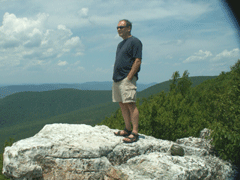
Virginia wilderness advocate Mark Miller views ridges he hopes will soon be added to the nation's wilderness system.
GELLERMAN: From the Jennifer and Ted Stanley Studios in Somerville, Massachusetts - this is Living on Earth. IÂ’m Bruce Gellerman, in for Steve Curwood. President Bush doesnÂ’t score high marks on environmentalistsÂ’ report cards. And congress doesnÂ’t do much better. But with just a few months left to his term, the president and lawmakers are trying to create an environmental legacy. Living on EarthÂ’s Jeff Young hit the trail to learn more.
[HIKING THROUGH DRY WOODS]
YOUNG: Wilderness advocate Mark Miller leads me through Virginia’s Shawver’s Run wilderness to a rocky outcrop he says has one of the region’s most spectacular views. Now, I grew up in the mountains. So I’ve got pretty high standards when it comes to pretty scenery. But when we reach the cliff, I have to admit—he’s right.
YOUNG: Oh yeah. That’s—that’s pretty.
MILLER: Yes this is what you’d call a million-dollar view. It’s just a series of sharp ridges with very narrow valleys—and from the mountain we have one, two, three, four, five, six, seven ridges that we can see from this location.
YOUNG: Wow.
YOUNG: The view also represents seven years of work by Miller and others with the advocacy group, Campaign for America’s Wilderness. That’s how long it’s taken to get the aptly named Virginia Ridge and Valley Wilderness bill before Congress. Fifteen hundred acres of the wooded slopes we see here would become wilderness, as would another 42 thousand acres in other counties—the biggest such land conservation measure in Virginia in 20 years.
Much of that acreage only made it in the bill after long negotiations with county officials; bear hunters who wanted hunters with disabilities to be able to drive into the brush, and mountain bikers who jealously protect their trail access.
MILLER: Yeah, we worked with the mountain bike community in some places, we worked with the horse community in others, and we worked with hunters in other communities.

Virginia wilderness advocate Mark Miller views ridges he hopes will soon be added to the nation's wilderness system.
MILLER: Yeah we had to make compromises but I think that the end result was that we had a bill that a lot of people could support and you try and ram something through the local community and youÂ’re dead before you even get started.
YOUNG: The work paid off. The bill held together through committee debate in congress and is now part of a package of wilderness proposals from other states, including West Virginia, Idaho, Colorado and Oregon.
Campaign for AmericaÂ’s Wilderness executive director Mike Matz says Congress could create more new wilderness areas this year than it has in the previous five years combined.
MATZ: There are about a dozen of them that seem incredibly viable this year that could make it to presidentÂ’s desk.
YOUNG: WhatÂ’s going on, why all these all of a sudden?
MATZ: Well it was kind of nice timing I think. Many of these things had been sort of percolating through, then all of a sudden stars aligned. TheyÂ’d gotten the support on the local level that they needed and the leadership changed and the leadership definitely is more favorable towards these sorts of things. ItÂ’s been less of a rocky row to hoe to get them done.
YOUNG: When Republicans controlled Congress, California Representative Richard Pombo controlled the House Resources Committee, which considers wilderness proposals. In 2004, this was how Pombo explained his opposition to a proposal for Washington stateÂ’s Wild Sky Wilderness, which would have included some areas with a few old roads and culverts.
POMBO: I believe wilderness is a very special status of protection that we have as a tool to protect land. It is not something that anyone ever imagined that we would be including roads and bridges and dams and developed areas and try to call them wilderness.
YOUNG: Pombo blocked the Wild Sky proposal three times. But in the 2006 elections Pombo lost, Democrats took control of Congress, and West Virginia Democrat Nick Rahall became chair of what he renamed the Natural Resources Committee. And this year the Wild Sky Wilderness became law.
RAHALL: I think the reason is a difference in philosophy. A lot of these are republican wilderness bills, they never could see light of day when that party was in control of this committee. Maybe they viewed it as locking up or preventing development. Under my leadership I think they have deserved to be recognized and passed and we have done that.
YOUNG: Rahall says a bipartisan approach to wilderness is important, and the proposals that succeed are those with strong local support across party lines.
Which brings us back to Virginia and Mark Miller.
[STREAM]
YOUNG: We take a break not far from the Brush Mountain section of the Appalachian Trail, another area on the verge of wilderness protection, and we skip some stones in CraigÂ’s creek.
[SKIPPING STONES: “ooh good one! That’s hard to beat!”]
YOUNG: The community near here is very conservative and not inclined to like big government telling them what they can and canÂ’t do in the forest. It might have seemed Miller had an uphill battle here at Brush Mountain.
MILLER: But the word ‘conservation’ is root to ‘conservative’ and these folks wanted the land behind their homes conserved.
[STREAM]
YOUNG: Miller knew people in the area were also concerned that a proposed high voltage power line might come through here - something a wilderness designation could keep at bay. That helped him turn local skeptics into ardent supporters.
MILLER: A lot of times what folks in local communities say is ‘We want it just the way it is.’ One of the ways to make something stay just the way that it is, is to give it a wilderness designation. We’ll be long gone, but it will still be here.
YOUNG: “In wilderness is the preservation of the world,” wrote Henry David Thoreau. For this little corner of the world that preservation is nearly here.
For Living on Earth, IÂ’m Jeff Young in VirginiaÂ’s Jefferson National Forest.
Endangered Again?

The American Bald Eagle population recovered after being protected under the Endangered Species Act, and was de-listed in 2007.
GELLERMAN: Since the Endangered Species Act became law in 1973 – more than thirteen hundred animals and plants have been put on the list to preserve them and protect their habitat. But from the very beginning, opponents - principally mine owners and lumber companies - have tried to change the law. And now, in its final months in office, the Bush administration is proposing sweeping revisions to the Endangered Species Act that critics say threaten the law itself with extinction. The changes would streamline section seven - the scientific review of federally funded projects - that’s used to determine if plants and animals are in jeopardy. Kaush Arha (Kosh R-ha) is the Deputy Assistant Secretary for Fish, Wildlife and Parks at the Department of the Interior.
ARHA: What the proposed rules do is to provide directions towards federal agencies as to which way to make the calls on those very marginal areas, youÂ’re not sure as to whether itÂ’s going to have an effect, may effect, or no effect. ThatÂ’s always sort of a gray area.
GELLERMAN: The administration wants to make it crystal clear that section seven canÂ’t be used to protect potentially threatened species from projects that emit greenhouse gases.
ARHA:It would be irresponsible and improper to use an endangered species act as a backdoor way to regulate or address global warming.
GELLERMAN: That’s Kaush Arha (Kosh R-ha) of the Department of the Interior explaining the Bush administration’s plan to revise the Endangered Species Act. Lisa Heinzerling has looked at the proposal – she’s a professor at Georgetown University Law Center – welcome!
HEINZERLING: Thank you for having me here.
GELLERMAN: According to the Department of the Interior, the changes focus exclusively on Section seven of the Endangered Species Act and according to them its just a minor change, you know.
HEINZERLING: Yeah, thatÂ’s wrong. The changes allow an agency, lets say the Department of Transportation, which is proposing an action that may effect an endangered species to make the call about whether that effect will occur without consulting with the wildlife agencies. And so the agencies such as the Department of Transportation have first of all no substantial expertise in deciding whether these effects will occur with respect to endangered species. And second of all they like building highways, building dams, and so forth, they are not primarily interested in protecting species and for that reason the statute requires cooperation between the agencies interested in doing things like building highways and the wildlife agencies that are interested in protecting species.
GELLERMAN: So when the Department of the Interior and Mr. Arha say this is just for streamlining, to clarify the project proposal process, you sayÂ…
HEINZERLING: Those are euphemisms. Streamlining in this administration is simply a euphemism for deregulation. And so this, sure, it will streamline the process by cutting out a major protection of the act for species.

Professor Lisa Heinzerling specializes in Environmental Law at the Georgetown University Law Center. (Courtesy of Georgetown University)
GELLERMAN: You know it was just a few months ago that the Secretary of the Interior, Kempthorne, ruled that the polar bear is a threatened species because of climate change. And now that theyÂ’re saying specifically, as you heard Mr. Arha say, this you know we donÂ’t want to use the Endangered Species Act as a backdoor for regulating climate change.
HEINZERLING: It is quite noteworthy that the agency has found it necessary to change longstanding regulations in order to avoid the conclusion that the statute applies to climate change. So its taken significant steps to strengthen causation requirements, to tighten the kind of scientific evidence that’s required in order to protect species, simply in order to promote its own policy view that the statute doesn’t work for this problem. And so to say that the statute is a backdoor way of regulating climate change, I think gets the cart before the horse. You should look at the statute and see what it says and whether it addresses the problem. And if you don’t think it should, then go to Congress for a correction. But what the administration here has done is to say, “We don’t think its a good fit for this problem and so we’re going to declare it inapplicable.”
GELLERMAN: Well why didnÂ’t they go to Congress? I mean it was Congress who made the law, itÂ’s Congress who changes the law.
HEINZERLING: Yeah, in fact they went to Congress a couple years ago to try get the act changed and they were unsuccessful and so I view this as a kind of last gasp attempt to make the statute weaker and to try to ensure that the statute doesnÂ’t lift a finger to address climate change.
GELLERMAN: The Endangered Species Act has been around for more than 35 years now, 1,350 and some odd species have been put on the endangered or threatened list. The administration would say, “You know, it’s not working.” Only 17 of the species have recovered, nine or so have gone extinct while on the list, the thing’s not working, we need to fix it.
HEINZERLING: I think thatÂ’s the wrong way to look at it. I think a better way to look at it is to think about what might have happened if the act hadnÂ’t been in place. ItÂ’s not so much exactly how many species have recovered, but how many would have been imperiled if these protections had not been there.
GELLERMAN: Lisa Heinzerling is a professor at Georgetown University Law Center. She specializes in environmental issues
Related links:
- The Department of the Interior's proposed changes to the Endangered Species Act
- Professor Lisa Heinzerling
[MUSIC: Issac Hayes “Theme From Shaft” from The Ultimate Issac Hayes: Can You Dig It (Stax Records 2005)]
GELLERMAN: Coming up: iPods are for the birds - so donÂ’t fly away - stay tuned to Living on Earth.
[MUSIC: Herbie Hancock : “Butterfly” from The Essential Herbie Hancock (Columbia Legacy 2006)]
Invasion of the Invasives
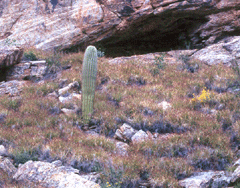
Buffelgrass plants surrounding a young saguaro cactus, Saguaro National Park, Arizona.
GELLERMAN: It's Living on Earth, I'm Bruce Gellerman, with this encore edition. The Sonoran Desert extends from northwest Mexico into most of southern Arizona and part of California. It's a landscape stark and beautiful, a huge hot desert, full of unique animals, colorful birds and bizarre plants. Among them - the giant Saguaro Cactus. You know, the one that looks like a giant scarecrow, with spiny outstretched arms. But now the saguaro has to fend off a new threat: non-native grasses. They're spreading like wildfire – and that's the problem. The rapidly growing grasses burn fiercely – as Jim Williams of KUNM Radio found when he visited Saguaro National Park near Tucson, Arizona.
NATS: [Hacking at buffelgrass, pulling, grunting.]
JOHNSON: You give it a, sometimes a good twist here, kinda like a rope it holds it together better. They get down in the crevices, which makes it a little more creative to get 'em out.
WILLIAMS: On an afternoon that would be called hot by most anyone not from Arizona, Matt Johnson hacks away with a steel pick on a rocky slope in Saguaro National Park. He's one of eight volunteers from the Arizona Native Plant Society who are pulling a stubborn non-native plant called buffelgrass.
GRAFFAM: Incredible.
WILLIAMS: Clint Graffam says he can't believe how fast this Sonoran desert's filling up with these wheat-colored clumps.

Buffelgrass plants surrounding a young saguaro cactus, Saguaro National Park, Arizona. (Photo by Todd Esque, USGS)
WILLIAMS: Buffelgrass is from Ethiopia, where it was named after the buffalo who loved it. The U.S. government imported it in 1938 and planted it in trial plots for use as cattle food and to reduce soil erosion in the American Southwest. Back then, it had a difficult time getting established. But fast-forward about seventy years, and it's now found its way to roadsides in Tucson, and within the past few years itÂ’s spread like, well, wildfire, up into the desert and onto its surrounding hillsides. Some scientists believe global warming could be fueling the spread: Tucson's in a multi-year drought, and average summer temperatures have been increasing. Whatever the reason, though, buffelgrass loves it here now. And while the sight of it is troubling, botanists and ecologists are most worried about the fire it will inevitably bring. The grass, which is tinder-dry and dormant for most of the year, burns quickly and at very high temperatures. Matt Johnson has just cleared a skirt of bufflegrass from around the base of a massive saguaro.
JOHNSON: This saguaro will not now burn if a fire were to come start tomorrow in this remaining patch of grass, and kinda like people, saguaros, if they get more than about sixty percent of their stem surface burned, same as severe burn victims, the survival rate goes way down. Just a little singeing around the base they'll handle, but, Whew! [Laughs.]
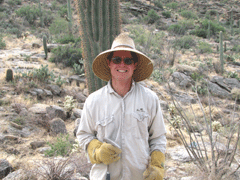
Volunteer Matt Johnson holds a clump of buffelgrass. (Photo: Jim Williams)
HANSEN: There are a lot of homeowners in the foothills and such that have major infestations of this grass. I don't know how aware they are, but this poses a real threat to their property as well. This grass burns very vigorously with very tall flame. And it's easily able to destroy a house, and all the plants, including saguaros, around it.
BETANCOURT: It is the plant from hell.
WILLIAMS: Julio Betancourt is a senior scientist with the U-S Geological Survey. In recent years, he's been all over the media around the world talking about buffelgrass. Betancourt stands and points up at the southern base of the Catalina Mountains, which rise out of what's quickly becoming north Tucson.
BETANCOURT: And you can see all these patches, like do you see that patch right down there, that's buffelgrass right there. Do you see that patch over there next to Pima Canyon? Buffelgrass. When you start looking down the mountain you start picking out all these little patches. And that's all buffelgrass, and eventually, the whole ridge will be buffelgrass.

Pima Community College student Shelly Lyons digs up buffelgrass as part of her biology class service learning project. (Photo: Jim Williams)
BETANCOURT: I think humans have this animalistic visceral reaction to changes on the landscape. And I think the same thing is already happening with the population in Tucson, that they notice something is changing, and changing very, very fast.
WILLIAMS: Well, the Park Service has noticed, that's for sure. It's partnered with the Arizona Native Plant Society and a relentless group named the Sonoran Desert Weed Wackers to build an impressive team of buffelgrass-tackling volunteers. But it's a foot race the grass seems to be winning. Meg Weesner is Saguaro National ParkÂ’s chief of Science and Resources Management. She says researchers are seeing native plants like the green-trunked paloverde and saguaro dying out in stands of buffelgrass, their water supply cut off by the invaders. Southern California has seen invasive grasses take over in similar ways in recent years. Weesner says think of the fires there as exactly what could happen in Tucson and Saguaro National Park.
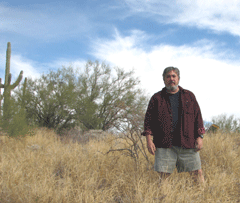
USGS Senior Scientist Julio Betancourt in a field of buffelgrass. (Photo: Jim Williams)
WILLIAMS: That process kills the native Sonoran plants, turning the desert into an African savanna, a grassland. In places in northern Mexico, thatÂ’s already happened. And itÂ’s an expensive problem. Buffelgrass has now spread into a thousand acres of Saguaro National Park. Without the help of volunteers, removing the buffelgrass can cost over $13,000 dollars an acre. Weesner says the park service has also begun herbicide spraying on the grass because digging it up can actually spread the seeds. But spraying costs $1200 dollars an acre. And because the chemical has to be absorbed by the plant, the buffelgrass can only be sprayed when itÂ’s green, which means a very short window of opportunity in the summer. Add to that the fact that the chemical is essentially a version of Roundup, which some studies have shown might harm soil bacteria and amphibians. But the volunteers out on the hillside in the park say fire is a much more immediate and devastating threat. Meg Weesner says all the challenges require a huge collective effort.
WEESNER: The park has partnered with almost everybody who manages a plot of large ground in the Tucson basin. We have all of the land managing agencies, all the departments of transportation, and we actually had a summit last winter to develop a coordinated effort, because it doesnÂ’t help to get rid of the grass on one side of the fence if itÂ’s on the other.
WILLIAMS: And with a lack of federal funding to deal proactively with invasives, Weesner says the Park Service is struggling to stay on top of it all. But she adds that, with the battalion of volunteers, the city of Tucson and Pima County all in on the buffelgrass fight, sheÂ’s hopeful.
WEESNER: You have to be an optimist in this field. [Laughs.] ItÂ’s the only way to be.
NATS: [hacking, pulling, and grunting sounds]
WILLIAMS: Back in the buffelgrass-choked Saguaro National Park, volunteer Matt Johnson keeps swinging his pick.
JOHNSON: ItÂ’s job security, I guess. [Laughs.] [hacking, pulling and grunting sounds]
WILLIAMS: For Living on Earth, IÂ’m Jim Williams, in Saguaro National Park.
Related link:
Saguaro National Park
[Ennio Morricone “The Good The Bad The Ugly” from ‘Film Music Maestro’ (Mbopglobal BCD—2004)]
Wireless Science
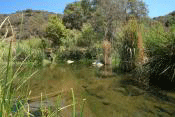
The creek in the Santa Margarita Ecological Reserve in San Diego County, California that hosts the water quality probes. (Photo: Monika Braun)
GELLERMAN: To probe nature’s deepest secrets and gather data, scientists sometimes have to trek into remote and forbidding places. But once there – they’ve got another problem - getting all that data home. As Spectrum Radio’s Jean Kumagai reports, researchers now have a new, faster system to retrieve and transmit their information – and that just might transform the way they do science.
[SOUND OF WALKING ON GRAVEL, MAN SAYS ‘BE CAREFUL, THERE’S SOMETIMES SNAKES THERE . . . ]
[SOUND OF WALKING ON GRAVEL, MAN SAYS ‘BE CAREFUL, THERE’S SOMETIMES SNAKES THERE . . . ‘]
KUMAGAI: Hans Werner Braun picks his way along a bramble-covered path at the Santa Margarita Ecological Reserve in San Diego County, California. He stops at the edge of a cliff, and looks down to a river below.
[SOUND FROM BABBLING BROOK]
KUMAGAI: Braun, a computer scientist at the University of California San Diego, says that this is one of the last free-flowing rivers in Southern California. The water burbles along through a narrow, cactus-studded gorge. ItÂ’s the dry season, so the river is more of a shallow creek at the moment. The idea is to keep the river and its surroundings as pristine and close to their natural state as possible. ThatÂ’s where Braun comes in.
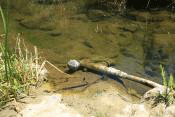
One of the probes used to sample the stream.(Photo: Monika Braun)
KUMAGAI: Over the past seven years, Braun and a few colleagues have built a high-speed wireless network linking up dozens of sites throughout San Diego County. ItÂ’s called the High Performance Wireless Research and Education Network, or HPWREN, and it allows researchers to monitor the tiniest facets of Santa MargaritaÂ’s ecosystem.
BRYANT: ThereÂ’s little fishes in here, craw-dads, all kinds of neat stuff.
KUMAGAI: San Diego State University biologist Pablo Bryant collaborated with Braun. Kneeling down at the riverÂ’s edge, he pulls a steel pipe up from the water.
BRYANT: This is essentially a multiprobe. Stainless steel. Screw the top off. And you can see itÂ’s got four probes in there, and these four probes have pH, dissolved oxygen, conductivity, and temperature.
KUMAGAI: The probes sample the stream every five seconds, and within half a minute, the data is sent through HPWREN and can then be accessed via the Web by researchers anywhere in the world. The reserve now boasts two other water quality probes, as well as 30 weather stations, more than a dozen remote cameras and wildfire detectors, and seismic sensors. Each device has a particular use. The cameras, for instance, are triggered by motion detectors, and they record any wildlife that happens to wander by the lens, such as hawks in flight and coyotes on the prowl. Data from all the sensors passes in and out of the reserve, via HPWREN, at a lightning fast 45 megabits per second. The use of wireless sensors and networks, Bryant says, is creating a paradigm shift in field research.
BRYANT: ThereÂ’s two things that are happening. YouÂ’re getting the data in real time, so you can see if a sensor fails or if your data is good. And you can also have many more sensors in the field. And all weÂ’re trying to do as technologists is create an infrastructure in a way to attract scientists to kind of do science in a new direction.
KUMAGAI: Looking at an aerial map of San Diego County, it’s easy to see why HPWREN has been so successful. The county covers some 4,500 square miles—about twice the size of Delaware—and the rugged geography makes it difficult for regular telecom companies to offer service at remote sites. That same forbidding terrain is ideal for the mountaintop radio antennas that form the backbone of HPWREN.
The network isnÂ’t just being used to study conditions on the ground. At the northern end of the county, atop Palomar Mountain, itÂ’s also helping astronomers gaze at the stars.

The creek in the Santa Margarita Ecological Reserve in San Diego County, California that hosts the water quality probes. (Photo: Monika Braun)
[SOUND OF CAR DOORS SLAMMING]
KUMAGAI: Braun drives his Jeep 4-by-4 up a winding mountain road, to Palomar Observatory. A scattering of gleaming white domes stands in a clearing. The observatoryÂ’s been operating since 1949, but newer, more powerful telescopes in Hawaii, Chile, and out in space threatened to eclipse older sites like Palomar. Spokesman Scott Kardel says connecting to HWPREN helps keep the observatory competitive.
SCOTT KARDEL: ItÂ’s through this antenna that we actually can move massive amounts of data and have automated telescopes that hunt for asteroids and look for planets around other stars and allows us to be an effective modern observatory, even on telescopes like this one that are 60 years old.
KUMAGAI: With the HPWREN connection, researchers can now do what’s called “rapid response astronomy”. Because astronomers can access their data almost immediately, instead of days or even months later, they can look for fleeting or fast-evolving phenomena, like asteroids and supernovas. If they happen to spot something interesting, they can track that patch of sky over consecutive nights or call up more sensitive instruments to take a closer look.
KARDEL: On the right is our 60-inch telescope and thatÂ’s automated to be a rapid responding telescope for gamma-ray bursts. So thereÂ’s a NASA satellite called SWIFT that locates them and sends a message directly to the computer there. And if the object is visible at Palomar and the weather is ok, itÂ’ll stop what itÂ’s doing and catch it. Usually it can be there making a measurement of the gamma ray burst within two minutes of the satellite having detected it.
KUMAGAI: Kardel says HPWRENÂ’s high bandwidth is giving new life to old telescopes. And scientists arenÂ’t the only people benefiting from the wireless network. Indian reservations, the San Diego SheriffÂ’s Department, and several state wildfire command centers are now connected, too. And, thanks to HPWREN, school children are able to explore places like Santa Margarita and Palomar right from their classrooms. Although Braun started the project as an academic exercise in computer networking, itÂ’s these real-world applications that keep him going.
BRAUN: My background is really in computer networking. ItÂ’s not wireless and itÂ’s certainly not sensors. But what is really interesting to me is being able to work with the applications, work with the ecological reserves, work with the astronomers, work with Native Americans, work with first responders, and so on. See what they really need, and come up with some cool new sensors that we deploy and develop together and make it work together.
KUMAGAI: Braun says heÂ’s happy to foster as many new research and educational connections as his network will allow. For Living on Earth, IÂ’m Jean Kumagai.
GELLERMAN: Our story on the researcherÂ’s wireless network comes to us courtesy of Spectrum Radio, the broadcast edition of IEEE (eye-triple-e) Spectrum, the magazine of technology insiders.
[MUSIC: Issac Hayes “Walk On By” from ‘Hot Buttered Soul’ (Stax Records—1969)]
Related links:
- HPWREN website
- Hans-Werner Braun bio
Birding... with an iPod?
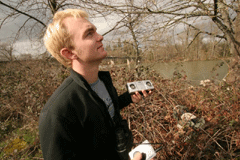
Noah Strycker dials up his ipod in the field. (Photo: Bob Keefer)
GELLERMAN: Ok birdersÂ…this budÂ’s for you. White ear buds that is. You know those tell tale signs of musical isolation that cut people off from the rest of the world? Well, what if the iPod could instead connect you with the great outdoors? Enter commentator Noah Strycker, who has repurposed the iPodÂ… for i-birding.
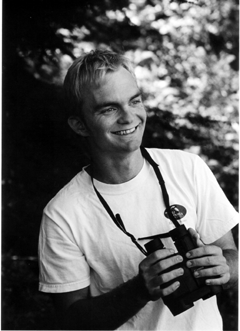
Noah Strycker (Photo: Bob Keefer)
STRYCKER: The little gizmo more than proved its worth one spring morning in an impressive demonstration in a patch of Ponderosa Pine forest. I was on a mission for a sighting and after I decided which songbird I wanted to see.
[IPOD DIALING AND SPARROW CALL]
I dialed up the pre-programmed call on my iPod, broadcast the song through an external speaker, and—bada bing!—there it was, a male Chipping Sparrow, hormones pumping, singing madly from the branch in front of me. Like magic. Dial-A-Bird.
In truth, iBirding is far from magic. You have to know exactly where the birds are and when they'll be there. Knowledge of vocalizations helps immensely, as you should be able to differentiate between an actual warbler song and a recording broadcast by the guy across the way with his own iPod. Occasionally, though, luck is all it takes.
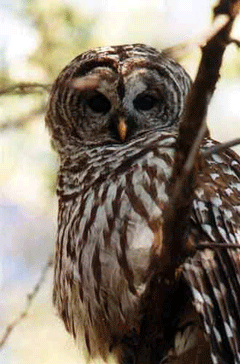
The barred owl, which Strycker summoned with his Ipod. (Photo: Noah Strycker)
On another occasion, it was near midnight, and I was standing alone in the inky blackness of an Oregon night. A creepy silence blanketed the scene. I had a tip that Barred Owls were in the area, and I wanted to see one. In the past ten minutes, however, nothing had stirred. It was time for Plan "B".
I dialed up "Barred Owl" on my trusty iPod and played the recording, a raucous Whoo-Cooks-For-You-All, twice.
[IPOD DIALING AND BARRED OWL CALL]
The silence intensified, suddenly, a loud swoosh sliced the air above my head and I aimed my light to find the owl sitting not five feet from my hat, staring down with somber, watery black eyes. I was out of there in a snap and home to bed before it could blink!
As a tool for modern birders, the iPod is both handy and reasonably inexpensive. It goes with your state-of-the-art binoculars, spotting scope, digital camera, long camera lenses, cellphone with pre-programmed Rare Bird Alert numbers, tuna sandwiches, and B-R-D, B-O-Y license plates. You can get everything but the plates—sorry, those are mine!

Noah Strycker dials up his ipod in the field. (Photo: Bob Keefer)
Don't expect an iPod to make you an elite birder. It can't replace actual knowledge and experience, and it takes a fair amount of time to set up. On outings, I follow common sense with my iPod, trying to be considerate and unobtrusive of birds' activities, especially in heavily birded areas, and never using playbacks for attracting any species that is threatened, endangered, or of special concern.
As a birding tool, the iPod can be a great way to reach out to the world around us. And that's cool not just for the iPod Generation, but for any generation.
GELLERMAN: Noah Strycker is the associate editor of Birding magazine, in 2004 he was named Young Birder of the Year. You can learn more about him in the book, Good Birders Don't Wear White: 50 Tips from North AmericaÂ’s Top Birders.
Related link:
Noah Strycker's website
[MUSIC: Endangered Species “Drum Talk” from ‘Dancing In The Trance’ (Global Pacific—1995)]
GELLERMAN: Just ahead: Sir David Attenborough and the art of discovery. Stay tuned to Living on Earth!
ANNOUNCER: Support for the environmental health desk at Living on Earth comes from the Cedar Tree Foundation. Support also comes from the Richard and Rhoda Goldman Fund for coverage of population and the environment. And from Gilman Ordway for coverage of conservation and environmental change. This is Living on Earth on PRI—Public Radio International.
[MUSIC: Aaron Parks: “Praise” from Invisible Cinema (Blue Note Records 2008)]
Amazing Rare Things

A red-billed toucan (Ramphastos tucanus), c.1705-10 (Photo: Courtesy of the Royal Collection)
GELLERMAN: ItÂ’s Living on Earth, IÂ’m Bruce Gellerman.
Elizabeth Windsor has some interesting pictures in her home – that would be Windsor Castle, where the Royal Library contains her collection of amazing rare things. Which happens to be the title of a book edited by Sir David Attenborough – who was knighted by Queen Elizabeth. His book – “Amazing Rare Things: The Art of Natural History in the Age of Discovery” - chronicles how 15th century artists depicted the strange and unusual specimens adventurers found in the New World. Living on Earth’s Steve Curwood spoke to Sir David about how the book came about.
ATTENBOROUGH: Well, the Royal Collection has a gallery attached to it and regularly shows things from the collection. There’s a great wealth of natural history drawings in the collection and we decided to do a selection from there. And I was invited to help in selecting the pictures and selecting the artists, which was of course an extraordinary privilege. I mean to riffle through—if I may put it that way—riffle through drawings by Leonardo da Vinci, is quite a privilege.
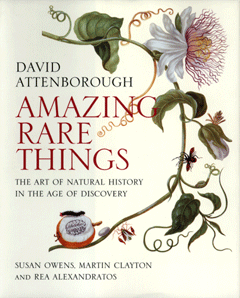
Amazing Rare Things Book cover (Courtesy of Yale University Press)
ATTENBOROUGH: Yes, I mean ‘artist’ is an inadequate word, really, for Leonardo da Vinci. I mean it’s an accurate word of course. Leonardo’s curiosity into how things worked is just mind-blowing. And the details and of course the sheer beauty of the drawings is absolutely extraordinary.
CURWOOD: Leonardo, the quintessential—perhaps the definitional—renaissance man. In your book, Sir David, you quote something that he wrote around 1490 that shows that he was even formulating a Gaia hypothesis. Could you read from that for us please?
ATTENBOROUGH: Well, Leonardo wrote: ‘Just as man is composed of earth, water, air and fire, so this body of the earth is similar. Whereas man has bones within himself, the supports and frameworks of the flesh, the world has rocks, the supports of the earth. If man has within him the lake of blood wherein the lungs expand and contract in breathing, the body of Earth has its ocean, which also expands and contracts every six hours with the breathing of the world. As from the said lake of blood arise the veins, which spread their branches through the human body. Likewise, the ocean fills the body of the earth with an infinite number of veins of water.’
CURWOOD: So indeed, a vision that the earth is an organism—the Gaia hypothesis—just like a human. And we get this from Leonardo da Vinci in 1490.
ATTENBOROUGH: ThatÂ’s correct.
CURWOOD: I guess todayÂ’s environmentalists should move over for a moment.

The uterus of a gravid cow, c.1508 (Courtesy of the Royal Collection)
ATTENBOROUGH: (laughs) But itÂ’s a remarkable vision, isnÂ’t it? And it shows such understanding of both the earth and the body.
CURWOOD: Perhaps one could say, of the people who are in your book, that theyÂ’re all at the same time artist-scientists. And perhaps thatÂ’s what, due to the time, that if youÂ’re going to tell the story of the things you were observing that you would need to have the pictorial representation and there was no one else to do it but yourself?
ATTENBOROUGH: Yes. But some weren’t even scientists. I mean it’s quite remarkable how you actually have to know how something works before you can draw it accurately. And that’s a very interesting little problem. I mean there’s a drawing from a man called Cassiano dal Pozzo, he commissioned artists to draw these things and the artist is faced with, for example, a sloth, or maybe you call it a ‘sloth.’ But it, as you well know, it spends its life hanging upside down. Now you couldn’t possibly know that it spends its life upside down if you’d just been sent the skin, unless you really understood the mechanics of the thing. And they looked at this and they naturally drew it as if it was standing horizontally but in the normal sort of way with its feet beneath it. And the result is, I mean to our eye, of course grossly unnatural—almost comic—because it doesn’t work that way. So you really have to understand about these creatures before you can draw them accurately.
CURWOOD: One of the most interesting characters, that IÂ’d never heard of before IÂ’d read your book, was this woman whoÂ’d went to Suriname. Can you tell me her story, please?
ATTENBOROUGH: Yes she—Sibylla Merian was her name—she was a widow and she earned her living selling insect specimens in Holland. And in the mid 50s she decided that she’d like to go and see many of these specimens that she had been selling, and draw them in the wild. And so off she hopped, with her daughter, to Suriname. And there she collected caterpillars and watched them as they metamorphosed into the adult insects, not knowing what they were going to turn into, and produced, as a result of this, some magnificent plates which subsequently became very famous indeed, and very beautiful they are, too. You can certainly tell a Merian drawing. She has a deep affection for curls. I mean she can’t resist a curl.

A red-billed toucan (Ramphastos tucanus), c.1705-10
(Courtesy of the Royal Collection)
CURWOOD: So what was her intended audience? For these early artists of nature—who was expected to look at their works?
ATTENBOROUGH: Well, buyers. There has been always people ever since the invention of printing, who buy books for the beauty of their plates. And what more beautiful subject can you have than animals and plants? And Merian, as I said, earned her living by selling insects by insect specimens but her books became very highly treasured and very sumptuously produced too, so that she made her living by selling her books.
CURWOOD: Now in your book, only a couple of the artists that you have here ever traveled outside of Europe to go visit some of these far-flung places like Indonesia or Suriname. How did the artists get access to some of the animals and plants that they painted?
ATTENBOROUGH: They were sent back to Europe—from Roman times onward. The Romans imported animals from Africa, sometimes to slaughter in the coliseum, but sometimes because they were really strange things. In the 16th century a rhinoceros was imported into Europe, and Albrecht Durer, the great German artist, drew pictures of this, which circulated around the whole of Europe because the image of this extraordinary armored creature was so remarkable. And of course there was a huge flood from the 16th century onwards, with the discovery of the New World. New creatures being brought in all the time. And people, you can almost see their jaws sagging as yet another extraordinary animal is unloaded from one of the ships.
CURWOOD: I have to say that looking at the work of some of these early natural history artists, I see a lot of abnormal or monstrous forms of creatures or dragons, of course, or deformed pieces of fruit. WhatÂ’s the appeal in seeking out these monsters of nature?
ATTENBOROUGH: Well it’s not unusual. We too think, in biology, that things that are abnormal, there is something to be learned from them. And there is also something exciting, which is something rare. I mean today people are fascinated by white tigers, for example. They think ‘my goodness, how extremely interesting they must be because of how rare they must be.’ Now biologically one knows very well that that is a very simple genetic change, which produces an albino, and these are albino animals and that albinism can be transmitted from one generation to the next. So we today still have this fascination with the rare and the odd. And of course, in a more superstitious age, a lot of people thought that these things were signs from the gods. And indeed today there are parts of the world where people will tell you that they’ve seen in a deformed root some Christian symbol or other.
CURWOOD: Sir David you’ve made a number of nature films, including, well most recently the stunning series “Planet Earth.” And thank you, so much. It’s a tremendous gift your work.

Pitch apple (Clusia rosea), c.1725 "This plant starts life as a seed scraped on to the branch of a tree by a bird or a bat. It sends down long roots to the ground, develops a large crown and eventually strangles and kills the tree on which it sits, continuing life as an independent tree standing sometimes sixty feet (18m) high. The resin from its stem is used to caulk boats."- David Attenborough (Courtesy of the Royal Collection)
CURWOOD: So tell me, to what extent do you feel that pull to the exotic, the unknown, in some of the work that you do?
ATTENBOROUGH: Oh I think all of us are drawn to seeing the unusual. I mean itÂ’s exciting to see the unusual. And itÂ’s very nice to think that you were the first person to see something.
CURWOOD: Tell me perhaps something you have perhaps seen for the first time. Maybe it was in a remote place. Tell me the story.
ATTENBOROUGH: Well I’m fascinated by birds of paradise; I have been since I was a kid. Don’t ask me why—well, yes, you can ask me why because I can tell you, because they’re—
CURWOOD: Why?
ATTENBOROUGH: (laughs) Thank you very much. Because they are unfailingly beautiful and extraordinary and unpredictable and in many cases unimaginable. I mean, there are 42 different species of them and they have amazing feather decorations, which the males display in courtship dances of great elaboration. And they live in a very very remote part of the world, that is to say Central New Guinea. And there are still species that have never been filmed before in performing their courtship dances
CURWOOD: Sir David before you go, could you tell us perhaps an illuminating or perhaps your most exciting travel story from all these many places youÂ’ve visited all these years?
ATTENOROUGH: Well, 50 years of doing it, it’s difficult to choose. But let me revert to birds of paradise. There was a particular bird of paradise I was wanting to see and it displays on the ground. It’s a remarkable bird, which clears a space—an arena—on the floor of the jungle, of the rainforest, removing with great care every little tiny twig, every little bit of dead leaf until the ground is absolutely clear. And then in the early dawn it dances. The male turns up, courts the female, the females assemble and then the male performs this amazing dance displaying his plumes to the females. Most of the time, at the end of the dance the females will just look at him and just fly off and you think you can hear them saying, ‘if that’s the best you’ve got, forget it!’ But if he’s lucky, you see, he’s going to be okay.
Anyway, we spent a long time looking for this. And at the end of six weeks we found an arena and it was on the top of a ridge in a very wet part of the rainforest of western New Guinea. And we set up a hide that night and I decided that in the morning—we had two hides, one side on each side of the arena—and the cameraman was going to go into one and I was going to go into the other. And we decided that we wouldn’t take a sound recorder, I would do what I could there, but also that we would have electronic system of talking—me talking to the cameraman so that he could hear what I said and I didn’t—we were whispering. And the bird came down and it did its dance and I was just simply thrilled to the marrow. And then the bird finished and flew away and the cameraman and I scrambled down this very steep side of the ridge towards our camp. And as we came down the recordist who we’d left in the camp—the sound recordist—came out and waved and I yelled back I said ‘We’ve got it! We’ve got it!’ And the recordist said, ‘I knew the precise moment that you saw it because through that microphone, which was on your chest, the radio microphone, I could hear your heart beat. And it suddenly doubled its speed.’ And that’s the reaction which one seeks to create in view of looking at television programs of the natural world. And in many ways that’s the reaction that I’m sure these artists, who are in this book, hoped to create and those who came to look at their drawings.
CURWOOD: Sir David Attenborough’s new book is called “Amazing Rare Things: The Art of Natural History in the Age of Discovery.” Thank you so much, Sir David.
ATTENBOROUGH: It was a pleasure.
GELLERMAN: Sir David Attenborough spoke with Living on EarthÂ’s executive producer Steve Curwood.
Related links:
- The Royal Collection: "Amazing Rare Things: The Art of Natural History in the Age of Discovery"
- David Attenborough's "Planet Earth"
YouÂ’ve heard of the movie: The Kiss of the Spider WomanÂ…well, this is the music of the spider man.
[VIBRATION SOUNDS]
GELLERMAN: To eavesdrop on spiders, Damian Elias (eh-LEE-ahss) uses a laser Doppler vibrometer, whatever that might be, Elias is a researcher at the University of Toronto. Producer Jeff Rice of the Western Soundscape Archive snared the spiderman at work.
ELIAS: One of the things about spiders and one of the reasons that IÂ’m interested in them, is theyÂ’re kind of maters of vibration domain. The ones on webs males, for example, pluck songs to the females.
[RYTHMIC SPIDER VIBRATIONS]
ELIAS: It really is like plucking a guitar string. But not all spiders live on webs and so a lot of other spiders they use sort of vibrations but theyÂ’re sort of vibrating on leaves or something like that, not webs.
[SPIDER VIBRATING ON LEAVES SOUNDS]
ELIAS: One of the wolf spiders that I work on make their sounds by drumming. They use the pedipalps, which are their genitalia basically, and theyÂ’re banging them against the ground in stereotype patterns. And they also use their legs so they use their pedipalps and their legs to drum this love song to females.
[WOLF SPIDER LOVE SONG]
ELIAS: Jumping spiders have these elaborate displays where they wave the different legs, they sway back and forth in a very sort of rhythmical fashion. ItÂ’s kind of like flamenco dancing I kind of see it as.
[JUMPING SPIDER THUMPING]
The surface that you heard vibrating is actually on a nylon surface, actually panty hose because itÂ’s just easier to control than say having them vibrate on leaves or rocks or something because they can be quite complicated, the vibration characteristics of them.
I basically came to it with an interest in sensory systems and I was interested in acoustics, vibrational or hearing. And they just happen to be such charismatic creatures, I find spiders very charismatic, that as soon as I started recording from them and it ended up that not a lot of work has been done so that really quickly fed upon itself and just really became a great system to study.
[SPIDER VIBRATION MONTAGE]
GELLERMAN: Damian Elias is a researcher at the University of Toronto. Our story was produced by Jeff Rice for the Western Soundscape Archive.
Related links:
- Universtity of Toronto News and Events Coverage
- Western Soundscape Archive
- The Institute of Museum and Library Services funds the Western Soundscape Archive
-
GELLERMAN: We leave you this week, in the midst of a summer nightÂ’s dream.
[EARTH EAR: Earth Ear: Bernie Krause "West " from ‘Midsummer Nights’ (Wild Sanctuary (BMI) – 2002)]
GELLERMAN: Bernie Krause recorded this insect chorus - and the occasional bullfrog - in the Cascade Mountains of Northern California for his wild sanctuary dot com soundscape series.
[EARTH EAR: Earth Ear: Bernie Krause "West " from ‘Midsummer Nights’ (Wild Sanctuary (BMI) – 2002)]
GELLERMAN: Living on Earth is produced by the World Media Foundation. Our crew includes Ashley Ahearn, Bobby Bascomb, Eileen Bolinsky, Ingrid Lobet, Helen Palmer, Mitra Taj and Jeff Young, with help from Sarah Calkins and Marilyn Govoni.
Our interns are Kim Gittleson and Jessica Ilyse Smith. Jeff Turton is our technical director. TodayÂ’s show was ably engineered by Luke Borders. Alison Lirish Dean composed our themes. You can find us at LOE dot org. Steve Curwood is our executive producer. IÂ’m Bruce Gellerman. Thanks for listening.
ANNOUNCER: Funding for Living on Earth comes from the National Science Foundation, supporting coverage of emerging science, and Stonyfield Farm: organic yogurt and smoothies. Stonyfield pays its farmers not to use artificial growth hormones on their cows. Details at stonyfield.com. Support also comes from you our listeners, the Ford Foundation, the Town Creek Foundation, and the Oak Foundation supporting coverage of climate change and marine issues, the Rockefeller Foundation and its campaign for American workers, more at rockfound dot org. And Pax World Mutual Funds: socially and environmentally sustainable investing. Pax World: for tomorrow. On the web at paxworld.com.
ANNOUNCER 2: PRI: Public Radio International
Living on Earth wants to hear from you!
Living on Earth
62 Calef Highway, Suite 212
Lee, NH 03861
Telephone: 617-287-4121
E-mail: comments@loe.org
Newsletter [Click here]
Donate to Living on Earth!
Living on Earth is an independent media program and relies entirely on contributions from listeners and institutions supporting public service. Please donate now to preserve an independent environmental voice.
NewsletterLiving on Earth offers a weekly delivery of the show's rundown to your mailbox. Sign up for our newsletter today!
 Sailors For The Sea: Be the change you want to sea.
Sailors For The Sea: Be the change you want to sea.
 The Grantham Foundation for the Protection of the Environment: Committed to protecting and improving the health of the global environment.
The Grantham Foundation for the Protection of the Environment: Committed to protecting and improving the health of the global environment.
 Contribute to Living on Earth and receive, as our gift to you, an archival print of one of Mark Seth Lender's extraordinary wildlife photographs. Follow the link to see Mark's current collection of photographs.
Contribute to Living on Earth and receive, as our gift to you, an archival print of one of Mark Seth Lender's extraordinary wildlife photographs. Follow the link to see Mark's current collection of photographs.
 Buy a signed copy of Mark Seth Lender's book Smeagull the Seagull & support Living on Earth
Buy a signed copy of Mark Seth Lender's book Smeagull the Seagull & support Living on Earth

